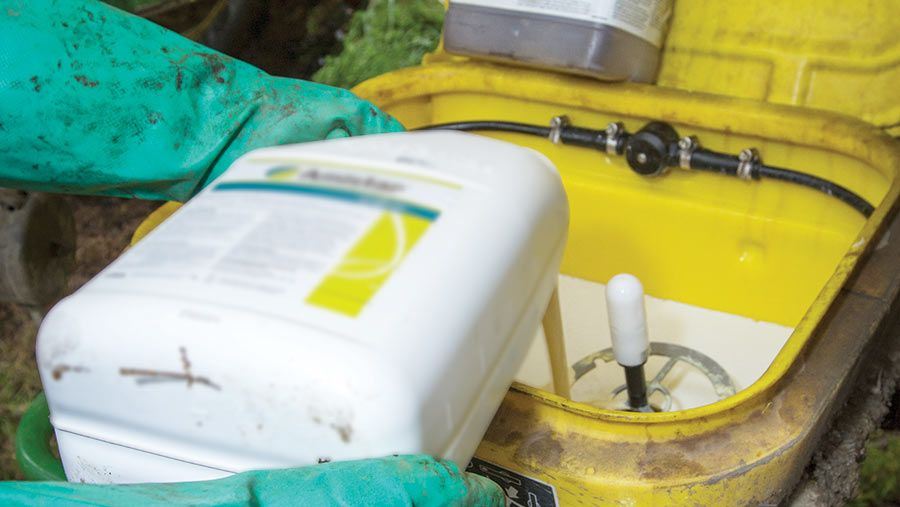Why SDHI fungicide strategies need to change in 2018
 Filling a sprayer with fungicide. © Gary Naylor
Filling a sprayer with fungicide. © Gary Naylor Experts are urging cereal growers to change their fungicide programmes this year, amid rising concerns about resistance development, with septoria already 20% less sensitive to the SDHIs than it was two years ago.
The current “belt-and-braces” four or five-spray approach adopted on many farms in winter wheat is driving resistance faster, warn experts, especially where the same chemistry is being used at successive timings.
Their concern is based on evidence that pathogens are continuing to become less sensitive to frequently-used chemistry. It follows a fall in efficacy of the SDHIs on septoria and uncertainty about the level of control that will be achieved in 2018.
See also: How to fight fungicide-resistant ramularia in spring barley
Added to this, the well-documented decline in azole and strobilurin performance, together with over-reliance on too few active ingredients, especially in wheat, has given the issue a sharper focus.

Fiona Burnett, Scotland’s Rural College
Fiona Burnett, Scotland’s Rural College – Respond to risk
“Growers must stop and think about what’s going on,” says cereal disease specialist Fiona Burnett.
“With the SDHIs starting to wobble, they need to question the use of blanket spraying, extra spray timings and the use of two SDHIs in a season. Instead, they should look at responding to local, varietal and seasonal risk.”
The warning signs provided by the septoria control in wheat model should be heeded, she suggests, so that lessons learned with other chemistry are used to avoid repeating the same mistakes.
“Remember that the strobilurins were lost very quickly in septoria in a couple of seasons, as they were used alone and in multiple applications.”
And although the azoles appear to have stabilised for now, she highlights that they have already lost much of their eradicant activity and half of their protectant power, from repeated use at low rates.
Given the latest findings, now is the time for the industry to take stock and realise that fungicide efficacy is in its hands, stresses Prof Burnett.
“Ahead of the new spraying season, everyone should reconsider and question their practices. Challenge yourselves and your agronomists.”
Target early sprays
Her advice for 2018 has a particular focus on the early sprays – T0 and T1 – which should be tailored to the situation found in the field, rather than being used as an insurance treatment.
“Fungicide use has not been fluctuating in response to seasonal risk. That needs to change, so that these products are being used sensibly.”
For example, later drilled wheat crops with low levels of septoria and no rust may not need a T0 spray, she advises.
“A year ago, we weren’t sure about yellow rust, so there was more reason for a T0. But now that we know that yellow rust races haven’t reshuffled again, a variety with a score of 8 or 9 should behave as expected.”
Likewise, decisions about the T1 spray should only be made after walking the crop, when the disease risk has been determined.
“Then it may be a case of ranking your crops, with more attention being given to the early drilled fields and weaker varieties. There is likely to be a spectrum of risk.
“Higher levels of disease and a risk of eyespot might justify the inclusion of an SDHI, but not all crops, all varieties and all fields will be at the top end of the risk spectrum.”
Reducing SDHI use
Including an SDHI at T1 shouldn’t be standard practice, agree our experts.
Their clear message is that the more SDHIs you apply, the more you will accelerate the resistance process – septoria is already more than 20% less sensitive to the SDHIs than it was two years ago.
While there will be situations where there is a mix of diseases present or the septoria pressure is already high, the need shouldn’t be an across-the-board decision.
The first year of a four-year research project on resistance management has confirmed that the biggest effect on the proportion of mutant septoria strains present in a population is the addition of a second SDHI to the programme.
They stress that an azole with a multi-site can bridge to T2 when applied at T1. The key is to make sure that the mix is properly balanced, with the azole being supported with at least the 1 litre/ha rate of chlorothalonil.

Jonathan Blake, ADAS
Jonathan Blake, ADAS – Use varietal strengths
There are three good reasons for wheat growers to consider dropping one of a possible two SDHI applications this year, says Jonathan Blake, principal research scientist with ADAS.
First and foremost, there’s a saving to be had, he points out. “Using an SDHI does add a cost to the programme, which may be as much as £10-20/ha.”
Second, applying an SDHI at T1 could make the septoria population less sensitive at T2, so affecting the efficacy of the later flag leaf spray and compromising control.
“We know that the septoria population is changing as a result of what we do, even within a season. Current practice means that growers are selecting for lower sensitivity in the way that they are using SDHIs.
“Worryingly, the speed of shift may be even faster than it has been with the azoles.”
Finally, there’s a resistance management reason – which if it isn’t taken seriously will result in the SDHIs being lost where they are needed most, he warns.
An SDHI at T1
“There isn’t always a case for an SDHI at T1, especially where the septoria risk is low and we’ve had some dry weather in the lead up to it,” says Mr Blake.
“Remember that the chemistry’s efficacy has altered, but we don’t know how much by. Building your fungicide programmes around other chemistry allows you to rely on what we do know.”
There’s good evidence that resistant wheat varieties sown later need either none or just one SDHI, he reveals, as well as work done over four years that shows there is no benefit from using two SDHIs on these types.
“These more resistant varieties have characteristics that allow you to cut back. Disease develops more slowly on them, so the early sprays don’t have the same job to do. That’s why it’s hard to justify the extra component.”
Rainfall in March and April will have a bearing, he accepts, and there will still be high-pressure situations where the best efficacy comes from using two SDHIs, at T1 and T2, along with partner products.
“Of course, it’s always possible to increase the loading of SDHI in the T2 mix instead, if the season changes. An azole/chlorothalonil mix at T1 can be enough until then.”
Mr Blake stresses that the less the SDHIs are used, the less they are selected against.
While there are some new fungicides in development, they are still a couple of years away and both have a single site mode of action.
“For that reason, we need the SDHIs to keep working. This is not just about bridging the gap until the new products come along.”
Fungicide efficacy – Where are we now?
Wheat and septoria
- Resistance to strobilurins since 2003
- Declines in azole sensitivity
- Issues with SDHIs emerging
- New chemistry limited and still 2-3 years away
Barley
- Issues with net blotch, mildew and Rhynchosporium
- Ramularia is an evolving picture:
- Strobilurins resistance since 2002
- Methyl benzimidazole carbamate resistance (2 forms)
- Emerging issue with SDHIs 2014
- Fall in field performance 2017
Fungicide Futures
Clear, consistent guidance on the use of low resistance risk fungicide programmes will be issued throughout the growing season by Fungicide Futures, a joint initiative between AHDB and the Fungicide Resistance Action Group.
Supported by most of the agrochemical manufacturers, the initiative will run for three years and will focus on converting anti-resistance science into practical farm action.
Growers and agronomists should look out for the information, which will be relevant to both wheat and barley, and will put anti-resistance management at the heart of fungicide planning. The first messages are expected later this month, just prior to T0.

